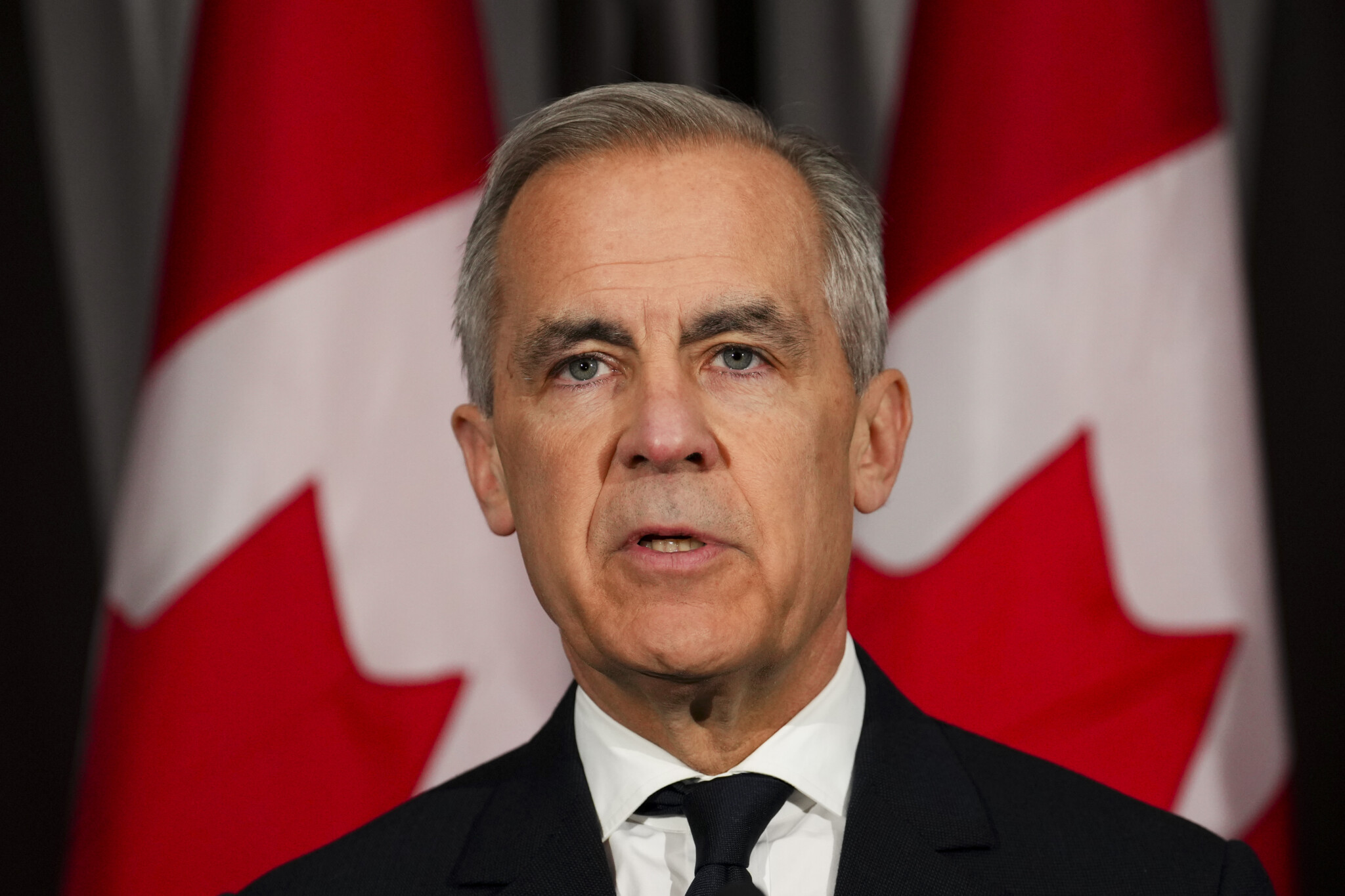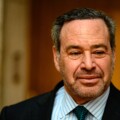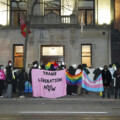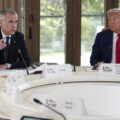And just like that, Canada’s long-awaited, much-analyzed federal election has come and gone. The still-somewhat-smoky scene this morning reveals a much different political landscape, with Mark Carney’s Liberals holding onto a minority (we think) government, the Conservatives growing their support and gaining key seats (though losing one particularly important one), and the NDP nearly wiped off the electoral map and losing official party status altogether.
What does this all mean for Canada? And what happens next? To sort through these obvious questions, we’ve gathered some of The Hub’s top insiders and experts to offer their insights and analysis for you.
This is just about the worst possible election outcome
By Caroline Elliott, a political commentator based in Vancouver
It’s no secret that Trump seeks a weaker, divided, and more dependent Canada. Ironically, in reacting to his belligerence, voters have delivered exactly what he wanted.
Of the likely outcomes, a Liberal majority would have allowed the Liberals to chart a course based on Mark Carney’s much-vaunted experience and credentials. Even for Conservative voters, a strong government with a clear direction would be a welcome change from the months of Parliament sitting empty in the face of Trump’s tariffs and threats to our sovereignty.
Another outcome might have been a Liberal minority combined with a small NDP presence amounting to less than the combined 172 seats required to form an effective government. This would have required Carney to undertake a very humble approach to governance until the tenuousness of his grasp on power soon resulted in another, hopefully more decisive, election.
Instead, the outcome is an approximately 168-seat Liberal minority that will rely largely on a small group of seven leaderless NDP MPs to push them over the 172 votes required to govern. These MPs will be motivated to prop up the Liberals as they buy time to choose a new leader and rebuild their war chest following a crushing defeat.
However, that support will come with conditions, giving the tiny NDP caucus an outsized influence on the direction of our entire country. They ran under a platform that represents the opposite of what Canada needs, including new spending at a scale Canada simply cannot afford and a refusal to commit to the new pipelines that are critical to reducing our trade reliance on the U.S. They’ve also pledged allegiance to a pro-Palestinian platform, and at least one of these MPs has proposed criminalizing certain forms of free expression which will doubtless lead to even more strife in our already divided country.
Unfortunately, we’ve given Trump just what he wanted: a worst-case scenario for Canada at a critically important time.
Canada’s new two-party political era is here—who’s going to make the most of it?
By Sean Speer, The Hub’s editor-at-large
The biggest takeaway from last night’s election results is the secular trend towards a two-party system—at least in English Canada.
This presents both opportunities and challenges for the Liberals and the Conservatives.
The Liberals’ absorption of 25-50 percent of traditional NDP support has proven to be an effective election strategy. It has broadened the party’s coalition, pushed up its popular vote, and enabled it to win new and different ridings across the country.
Yet it may present governing challenges. Mark Carney now presides over a progressive party with more ideological sensibilities than its traditional middle-of-the-roadism. One can envision policy tensions within the Liberal coalition on energy and the environment, Israel-Hamas, and identity politics. It may prove highly challenging for Carney to manage these tradeoffs in government.
For the Conservatives, the decline of the NDP has contributed to their notable gains with younger voters and realignment voters, such that the party’s voter composition is now quite different than it was in the Harper era. This has been additive to the Conservative voting coalition—including pushing the party’s share of popular support up to modern highs—as well as the issues and interests reflected in the party’s policy programme.
Yet the challenge is that if, as Darrell Bricker says, a two-party politics favours the Left coalition roughly 60:40, then the Conservatives need to figure out how to push their voter ceiling up even higher in order to compete with the Liberals head-to-head without relying on NDP-induced vote splits. The solution here isn’t self-evident. A shift to the centre, as some will invariably argue, could cause the party to bleed support on its right flank.
The key point here is that whatever the contingencies of this particular election, it’s a window into a different world of Canadian politics. The first between the Liberals and the Conservatives to figure it out could have a significant advantage in the next election, and possibly others to follow.
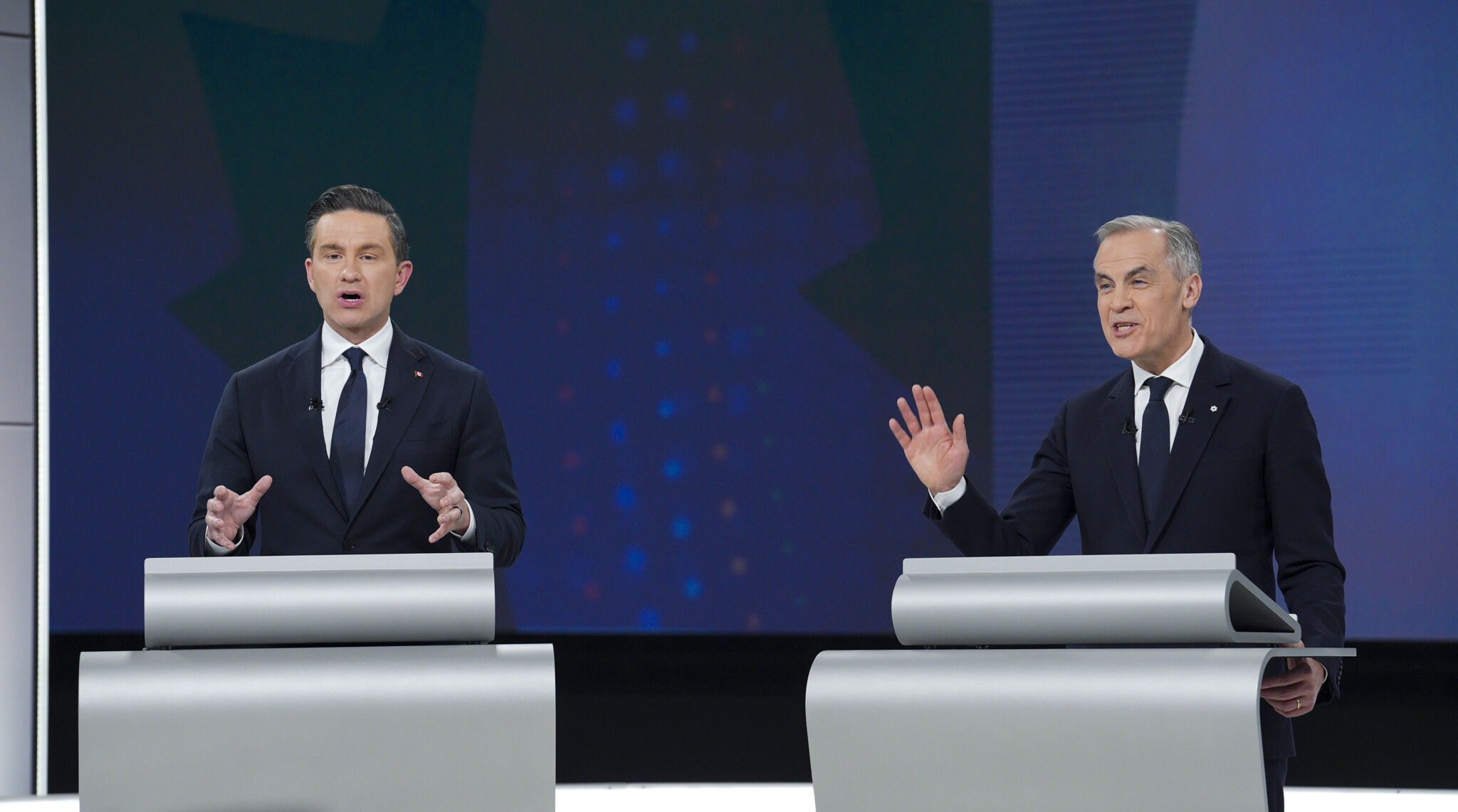
Conservative Leader Pierre Poilievre, left, and Liberal Leader Mark Carney participate in the English-language federal leaders’ debate in Montreal, Thursday, April 17, 2025. Christopher Katsarov/The Canadian Press.
Fear—not hope—won last night
By Anthony Koch, managing principal of AK Strategies who served as the national campaign spokesperson for Pierre Poilievre’s leadership campaign
The Conservatives earned their highest share of the popular vote since 1988. We built a broader coalition, inspired more Canadians, and won millions of new votes. And yet, once again, the Liberals clung to power.
Why? Fear.
Boomers, spooked by Donald Trump’s chaos south of the border, stampeded back to the Liberals. It didn’t matter that Trump isn’t on the ballot here. It didn’t matter that Pierre Poilievre ran a Canadian campaign about Canadian issues. Fear doesn’t care about facts.
The NDP, meanwhile, collapsed into irrelevance. Instead of offering a real alternative on the Left, they simply paved the way for a Liberal rescue operation. Progressive voters ran home to Carney, not out of love, but out of desperation.
It’s frustrating. It’s maddening. But it’s not the end.
The Conservative Party grew stronger last night. We planted roots in new communities. We proved that millions of Canadians are ready for something better. The Liberals bought themselves a stay of execution—nothing more.
The future wasn’t lost last night. It was delayed. And if we have the courage to keep fighting, it won’t be delayed for long.
The 905 couldn’t quite make up its mind
By John Ibbitson, journalist and author
Once again, the 905 decided a federal election. And if the election result is ambiguous, that’s because the 905 results were ambiguous as well.
Since the days of Lester B. Pearson, and with rare exceptions, the suburban 905 ridings surrounding Toronto, named after the region’s first area code, have tended to vote (a) as a block and (b) for whichever party formed government. Stephen Harper owed his majority government in 2011 to the 905; Justin Trudeau won three elections, two of them tenuous, because of support in the 905.
True to form, on Monday night, the 905 voted largely Liberal. Mark Carney will be prime minster in the next Parliament because of the 905.
But it looks as though he will lead a minority government, and the 905 contributed to that as well. For once, the region showed signs of political division. Some of the ridings on its outer rim—in Markham, Richmond Hill, Vaughan, and Brampton—elected Conservatives. Even the city of Toronto elected a Conservative in York Centre.
If those few ridings had all stayed Liberal, as in 2021, Carney would have enjoyed a majority government mandate on election night. Instead, as of this writing, it appears he will need to secure support from the Bloc Québécois or the NDP.
When suburban Greater Toronto is divided, everything becomes unsure.
The federal NDP aren’t just irrelevant—they could soon be entirely extinct
By Chris Ball, vice president of campaigns and communications at Counsel Public Affairs, former advisor to NDP leader Jack Layton
Monday’s results dealt the NDP a historic blow–losing official party status in Parliament. Jagmeet Singh’s resignation after losing his own seat in Burnaby Central marks the end of an era—one defined by principle, but ultimately not power.
The NDP must now make a defining choice: remain a marginal voice of conscience in Singh’s mold, or rebuild as a serious, disciplined political force capable of forming government. A party seen as the path to change, not one whining on the sidelines about strategic voting, punching down on Canadians for not seeing the NDP as a viable alternative.
Influence will be fiercely contested in this new, fractured Parliament. But with no formal status, the NDP will struggle to shape outcomes in a House defined by Liberal-Conservative polarization.
If the party chooses boutique activism and inward-facing leadership as its path forward—as some potential contenders to the leadership exemplify—it will retreat further into irrelevance. Canadians don’t need finger-wagging. They need a progressive party that fights to win, to govern, and to deliver for working people.
Winning power demands building a party rooted in the lives of working Canadians, and unafraid to govern boldly. The NDP holds power in British Columbia and Manitoba and forms the official Opposition in Alberta, Nova Scotia, Ontario, and Saskatchewan—they each have lessons to teach their federal cousins.
This is the moment for clarity and courage. If the federal NDP fails to evolve, it won’t just remain on the sidelines—it will be written out of the future of Canadian politics altogether.
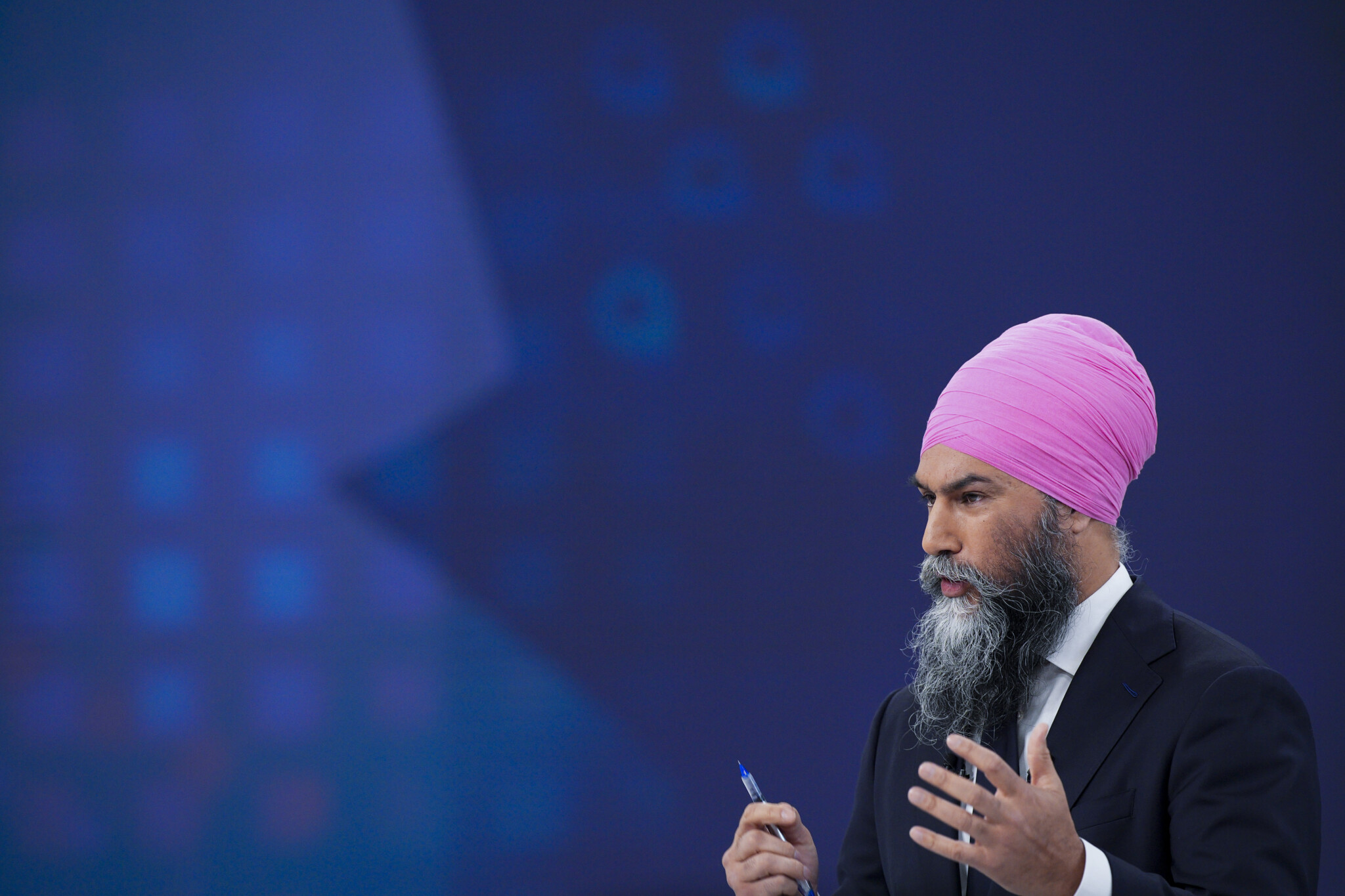
New Democratic Party Leader Jagmeet Singh participates in the English-language federal leaders’ debate in Montreal, Thursday, April 17, 2025. Christopher Katsarov/The Canadian Press.
Mark Carney’s British Columbia conundrum
By Kirk LaPointe, The Hub’s B.C. correspondent
The flight of voters from the NDP in British Columbia cost the leader his seat and the party a traditional beachhead as the Left Coast. Indeed, all three national leaders are gone from the Commons when it last sat.
The result creates a Conservative fortress in much of the mainland outside of Vancouver and Victoria—a useful future consideration—yet doesn’t deliver the province any obvious stars for Mark Carney’s cabinet should he wish to overhaul it.
The challenge for the prime minister in B.C. that got little campaign attention is how to handle the delicate China file and fine-tune the ambivalence Canada shows toward it. The province’s trade profile differs from the rest of Canada, with a more significant relationship to Asia generally (almost 36 percent) and China specifically (14 percent). Our geography and demography reflect a more practical commercial relationship with the region and its powerhouse.
Carney refers to China as the country’s largest security threat, not its most viable opportunity to diversify trade away from America. And he would know, just as Justin Trudeau knew, that any gesture to China is poking the American bear.
But that position leaves B.C. in a uniquely uncomfortable spot, trying to build upon the Asian imperative for our resources without being too obvious in any focus on its accessible economic engine. For all of Carney’s challenges with the White House, with the divided domestic political landscape, with the need to work with the Bloc Québécois, the vexing questions about China appear backburnered for now.
Mark Carney’s authenticity is a surprisingly impressive asset
By J.D.M. Stewart, author of Being Prime Minister
Mark Carney has been prime minister for fewer than 70 days (his win ensured Charles Tupper will remain our shortest-serving PM), so there is still a lot to learn about him. But we got some fun and interesting glimpses in the early hours of the morning Tuesday during his victory address and after when he milled about with supporters on the dance floor.
The prime minister is a droll and witty man. We saw one example of this during the campaign when he pretended to be getting instructions from the World Economic Forum via an ear piece. During last night’s address to Liberal Party faithful he gently admonished them when they mindlessly cheered his speech: “That’s not an applause line,” he told them with a wry smile. “That’s a fact.”
After the speechifying had concluded, the prime minister donned a red “Down With Webster” hoodie and took to the dance floor. I am not an expert, but I can say with reasonable certainty that the newly elected MP from Nepean executed his dance moves with aplomb. He did not look out of place and moved around the floor as though he truly belonged. He was being real.
We need more humour and authenticity in politics. Stephen Harper was known to have a superb sense of humour as well, but he decided to leave it out of his public persona. Not everything has to be scripted and controlled. Let’s hope the prime minister’s handlers are smart enough to let Carney be himself.
The expectations are sky-high for Carney—can he deliver?
By Sharan Kaur, former deputy chief of staff to Bill Morneau and campaign manager to Evan Solomon
Prime Minister Mark Carney’s victory last night signals more than just a change in leadership—it marks the return of competence, clarity, and credibility to Canadian politics, qualities we’ve sorely lacked during the recent Trudeau years. Voters placed their trust in a leader known not for slogans, but for substance. His calm, confident tone throughout the campaign reflected the kind of steady hand Canadians like me have been yearning for in uncertain times.
Canadians turned out in droves. We’re often left frustrated the morning after an election by low voter turnout, but this time, record-high participation (some 70 percent of the population) sent a clear message: change is possible—even without changing the party in power.
For Carney, the real work begins now. He must move quickly to assemble a team that mirrors the competence he projects and balance the old guard with fresh talent. Beyond managing the economy, he’ll need to bridge the divides that have deepened across geography, generations, and ideologies.
Canadians didn’t just vote against dysfunction—they voted for something better. The tone has shifted. The expectations are high—Carney is going to have to shed some of the old and bring in the new to change the rhetoric around the old Trudeau team. But for the first time in a long time, it feels like a grown-up is back in charge. Now it’s time to deliver.
The Liberals outspending the Conservatives on social media down the stretch could have been key
By Cole Hogan, a conservative strategist
From April 20 to April 26, the fifth and final week of the campaign, Pierre Poilievre’s Conservatives spent $1,000,000 on Meta platforms. The Conservative ad spend increased $540,000 from the previous week’s spend, $459,000 from April 13 to April 19.
Mark Carney’s Liberals spent $1,500,000 on Meta platforms from April 20 to April 26, surpassing the Conservative ad spend of $1,000,000 by $500,000. The $1,500,000 spend by the Liberals is an increase of $700,000 from their ad spend the week prior, April 13 to April 19, where Liberals spent $825,000. Over the final two weeks of the campaign Liberals consistently increased their ad spend, representing a considerable advantage in terms of the number of online users reached.
In the first four weeks of the election, Liberals spent $682,000, $697,000, $513,000, then $825,000. In the first four weeks of the election, Conservatives spent $698,000, $565,000, $458,000, then $459,000. The gap between the amount spent by Liberals and Conservatives widened in the fourth week of the campaign, April 13 to 19. In the final full week of the campaign, April 20 to April 26, the Liberal spend jumped to $1,500,000 while the Conservative spend jumped to $1,000,000. Throughout the timeframe of the election, the Liberals spent the highest weekly amount of all parties, $1.5 million in the final week.
For the last full week of the campaign the most viewed Conservative advertisement was a video ad featuring Pierre Poilievre. In this ad Poilievre speaks directly to young people about home ownership, the Liberal record on housing costs, and Conservatives policies to address housing costs.
The most viewed Liberal advertisements in the last week of the campaign were video ads featuring dogs, encouraging online users to make a plan to vote. Other Liberal ads compelled online users to get their friends to the polls, and featured Mark Carney speaking about how this election is about who is best to stand up to Donald Trump.
Jagmeet Singh’s NDP weekly ad spend increased from $44,000 to $50,000. This is the largest amount the NDP spent during this election, but greatly paled in comparison to the amounts spent by Liberals and Conservatives. Throughout the election, the NDP’s advertising was primarily focused on advertising local candidates across the country. The NDP’s most viewed advertisement in the last week of the campaign featured Jagmeet Singh speaking about health are, dental care, and pensions. In this ad, Singh argues that one party holding all the power would mean cuts to “the things who make us who we are.”
